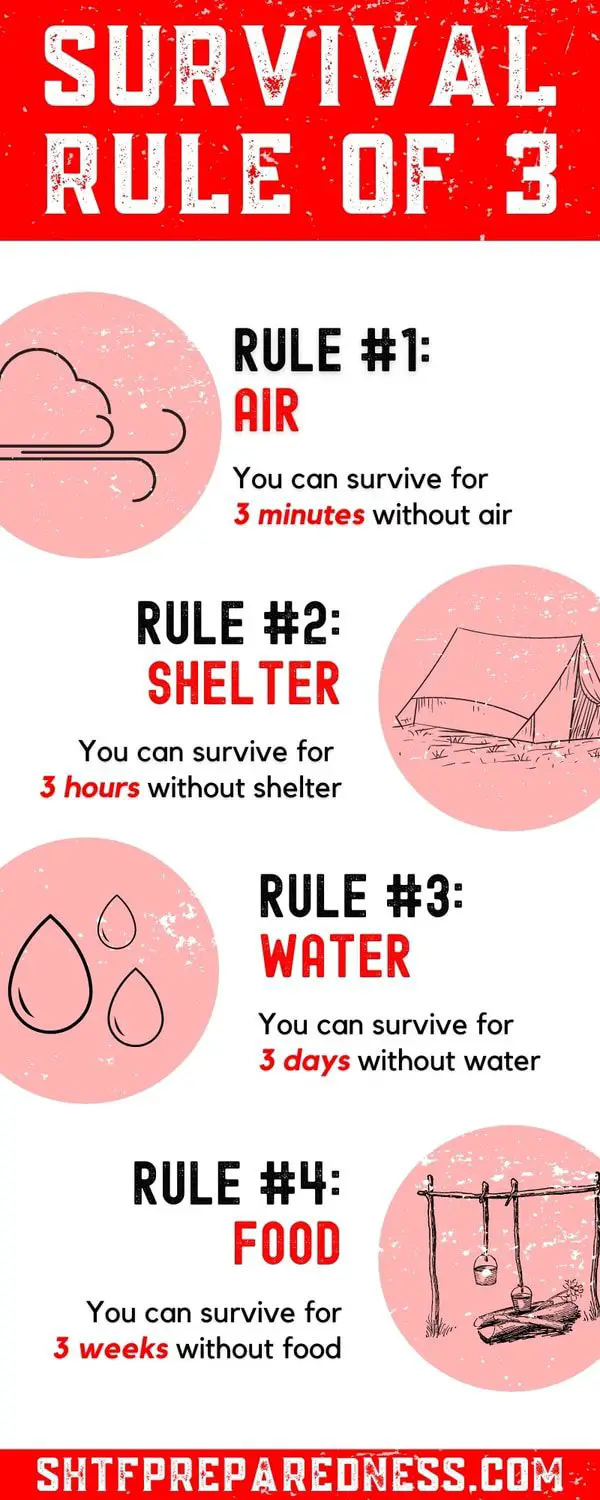The Rule of 3 is the foundation of knowledge among the active outdoor community because it represents the starting point of survival.
They are so basic yet so important to human survival that it would benefit anyone to know them. And they are super easy to learn and remember!
What is the Survival Rule of 3?
The basic rules of human survival have been around for as long as human history, as they are based on basic human biology. The survival rules are as follows:
- You can survive for 3 minutes without air.
- You can survive for 3 hours without shelter.
- You can survive for 3 days without water.
- You can survive for 3 weeks without food.
Is the Rule of 3 True?
The rule of 3 is true in terms of which items are more important than others for survival.
It is important to remember that the timeframes within the rules are not absolutes. Several variables will affect those durations, making them shorter or longer. But they are a good set of guidelines for keeping your priorities straight.
Wilderness Survival Rule of 3
When putting together your bug out bag or survival kits, make sure to keep these rules in mind. Each piece of gear must have a purpose to solve one of the rules at least.
Rule #1: 3 Minutes Without Air
As critical as this rule is, it is often and easily dismissed. Not much is talked about under this topic when these guidelines are brought up. Here are a few things to keep in mind as it relates to getting enough oxygen.
How to Survive with Limited Oxygen
Here are some quick tips:
- If you find yourself in an enclosed space without an immediate way out, see if there is a way of introducing fresh air into that space before working on your exit plan. And it is a good idea to slow your breathing as much as possible; this will also help to keep you calm.
- Two basic first aid skills that everyone should know how to perform are CPR and the Heimlich maneuver. Breathing in air is just the first step, oxygen then needs to be circulated throughout the body, which is where CPR comes into play. Choking can happen without warning, and when it happens, it needs to be addressed immediately. It is critical to know how to perform the Heimlich maneuver on someone else as well as on yourself.
Rule #2: 3 Hours Without Shelter
Making a shelter is quite important, but this rule needs to be explained just a little bit more. Ultimately, what this is referring to is maintaining core body temperature.
In fair weather conditions, many people have slept under the stars and were simply fine. A shelter provides protection against adverse conditions that can affect core body temperature.
How to Survive in Extreme Cold
Here are some quick tips for surviving in cold weather.
- Avoid cold sinks. These are low areas where the temperatures will be colder.
- Insulate a shelter by filling in any gaps in the building material.
- Smaller shelters will be easier to warm with a small fire and will retain heat better.
- Move around. If you don’t have a fire, do light exercises and work large muscle groups to help generate heat.
How to Survive in Extreme Heat
Here are some quick tips for surviving in extreme heat.
- Set up a simple shelter first to avoid heat exhaustion. Shaded areas can be twenty degrees cooler than surrounding areas.
- It will help to keep it cooler in a shelter if there is a way for air to circulate through it.
Rule #3: 3 Days Without Drinkable Water
Water is essential for life, especially in the short term.
Even one day without it in a survival situation, you will feel its effects. While people have been known to go longer than three days without water, this is an area not to mess around with.
A source of water needs to be found and thoroughly cleaned before consumption. Learning how to purify water will be a critical survival skill at this point.
How to Find Water in the Wild
Here are a few quick tips for how to find water in the wild.
- Use an absorbent material (like a cotton t-shirt) to collect morning dew off of plants.
- Create a solar still to collect water from green vegetation.
- Dig into the soil in damp areas and wait for groundwater to seep in.
Rule #4: 3 Weeks Without Food
How long a person can survive without food depends on the amount of fat and muscle in their body. As uncomfortable as it may be, we can go for a long time without eating a single thing.
How to Find Food
Here are a few quick tips for finding food in the wild.
- It is all about knowing how to snare or trap small game and creatures that can’t easily hurt you.
- Know your wild edibles because food is abundant all around us. But be sure you know them well to avoid consuming something poisonous!
Conclusion
When you find yourself in a survival situation, use the survival rule of 3 to prioritize what needs to be accomplished.
It is important to keep in mind that the timeframes within these rules are not absolutes but guidelines.
The circumstances surrounding the situation can shorten or lengthen those durations. Remember oxygen, shelter (maintaining core body temperature), water, and food in that order. Stay Safe!
